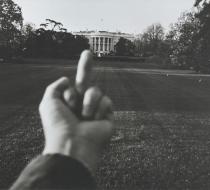Study of Perspective (& Stools) Favorite
The son of an exiled political dissident, Chinese artist and activist Ai Weiwei’s work is inherently political. Since 1995 Ai Weiwei has been traveling the world, photographing himself flipping off iconic monuments of power in his Study of Perspective series. Describing his photographic project as his personal rebellion against government authorities that disregard the freedoms of the citizens they claim to protect, his series has been extremely controversial. In addition to his photographic work Ai Weiwei also installs large-scale installations and sculptures that aim to spur conversation about abuses of power, exclusionary and arbitrary political borders, and governmental censorship and reductions of freedoms. By utilising traditionally Chinese forms such as the ubiquitous stool that can be found in any parochial Chinese town (see image above), Weiwei alludes to the social and political issues of his home country though his work could be seen as universal.
*Stools is the project featuring the diptyche.
*Study of Perspective is the photo Weiwei took flipping off the White House in 2015.
The story above is linked to both works so I'm featuring both works; however the rest of the Actipedia information will be about the photography.







